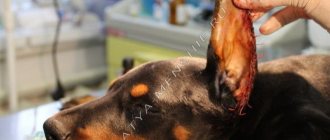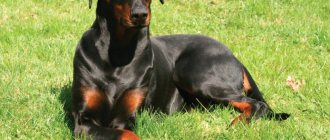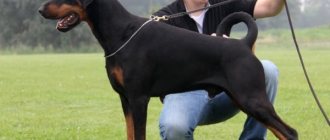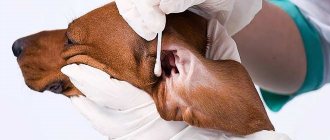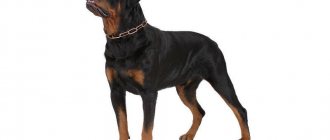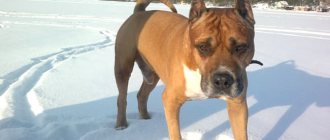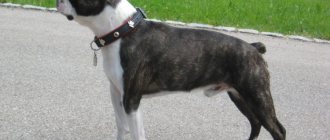Animal rights activists actively condemn this operation, citing its harshness and unreasonableness. Due to numerous disputes, it is not entirely clear whether it is possible to dock a dog’s tail or whether it is still worth preserving the natural appearance of the animal.
The official ban on amputation of the tail vertebrae in Russia has not yet been adopted, so the final decision remains with the owner. To avoid remorse, be sure to familiarize yourself with possible complications before signing up for the procedure.
What is cupping
Docking is the amputation of part of the tail by cutting or dragging. This procedure began in ancient Rome.
How did the idea of cutting tails come about?
The Romans docked their dogs for their own safety. Circumcision was performed on fighting breeds to reduce the likelihood of injury during gladiatorial fights. Also, a docked tail was the hallmark of hunting and herding dogs.
In the Middle Ages, people believed that short-tailed pets were reliably protected from rabies. Among the really weighty arguments are convenience and less trauma. The neat appendage collected less dirt and did not interfere with the pursuit of game in thorny bushes or a dark hole.
Not without human cunning. In the 18th century, Europeans docked their pets to evade taxes. It was charged for any purebred four-legged animals not engaged in official work. Whether a dog belonged to the police or security service was determined by the length of its tail, so unscrupulous owners quickly figured out how to reduce their expenses.
Do modern dogs need this?
Most modern pets do not perform their main functions (hunting, guarding). Owners are increasingly purchasing dogs for the soul - as ordinary companions. For this reason, in the 20th century, a convention was adopted in Europe that banned cupping at the national level. It was signed by most countries, including Australia and South Africa, which are very far from European territory.
As an exception, it was allowed to dock animals working in the police, army, rescue and deratization services. For everyone else, they made concessions, changing the established standards. The changes made allowed people to freely participate in dog shows without body modification.
Indications
So, the main reason is breed standards.
There are medical indications. These include:
- wounds, burns of the ears;
- tumors, local inflammation, ulcers;
- tissue necrosis;
- other serious damage.
Pets with short ears are less likely to experience bites and injuries. For guard dogs, it's a matter of vulnerability.
Most often, the operation is performed on representatives of the following breeds:
- Caucasian and Central Asian Shepherd Dogs;
- Dobermans;
- Staffordshire Terriers;
- Great Danes;
- Giant Schnauzers;
- pit bull terriers.
Today, many owners prefer not to crop their pets' ears because of the pain of this procedure. Animal rights activists and some dog experts are against it.
Some international exhibitions allow undocked dogs to participate, regardless of breed standards.
At what age do dogs have their tail docked?
The owner decides when to dock a puppy’s tail, but veterinarians recommend not delaying it. After 1 month, pain sensitivity increases greatly, so it is best to circumcise before this point.
Surgery is easiest to tolerate in the first 3-10 days after birth. During this period, the tail vertebrae are very soft, and babies lack pain memory and increased sensitivity. For this reason, they do not require anesthesia or suturing, but animals older than 10 days are operated strictly under anesthesia.
Unclear Benefits
Although ear and tail docking are performed primarily for appearance, many owners and breeders say that removing the tails of hunting and farm dogs can prevent injury during chasing or herding.
Others say docking keeps high-energy breeds like boxers from getting hurt by their tails by hitting them against walls or dog crates. Some owners believe that ear trimming reduces the likelihood of infection.
James Serpell, Ph.D., director of the Center for Animal-Society Interaction at the University of Pennsylvania, argues that docking itself can be considered trauma.
On the other hand, he says, "research shows that an undocked tail is unlikely to be injured, and if it does occur, the injuries are usually minor and heal easily."
Research shows that at least 80 percent of dogs don't get ear infections, "and the breeds that are most susceptible to them, such as cocker spaniels and poodles, have uncropped ears," Patterson-Kane says.
What dog breeds have their tails docked?
The mandatory presence of a docked tail is enshrined in the breed standard. The dog must conform to the exterior to participate in exhibitions and matings, but at this particular moment they increasingly turn a blind eye.
It is worth noting that many CIS countries and Russia still adhere to established traditions. Owners living there may find it difficult or even impossible to assign breeding or show class status to their pets if they refuse the operation.
List
The most famous representatives include
:
- poodles;
- kurtshaars;
- drathaars;
- Hungarian cops;
- Airedale Terriers;
- English and American cocker spaniels;
- boxers;
- Dobermans;
- toy terriers;
- Rottweilers.
The recommended tail length for these breeds is different. For this reason, it is very important to find an experienced veterinarian who is aware of all the nuances.
Determining the length of the ponytail
Most often, animals are left with 1/2-1/3 of their natural length or even 1-3 tail vertebrae. It all depends on the specific breed:
- poodles – 1/2-2/3;
- kurtshaars – 1/2-3/5;
- drathaars – 1/3-3/5;
- Hungarian cops – 1/2;
- Airedale Terriers – 1/3;
- English and American Cocker Spaniels – 2/5-1/2;
- boxers – 2-3 vertebrae;
- Dobermans – 2-3 vertebrae;
- toy terriers – 2-3 vertebrae;
- Rottweilers – 1-2 vertebrae.
Exceptions include wolfhounds. Their final length is determined solely by the owner.
The price of the procedure at the vet. clinics
The price of the procedure will depend on the method of docking, the age of the animal, and the location of the operation. Calling a veterinarian to your home is always more expensive than visiting a clinic.
On average, docking costs owners 700-1200 rubles, but depending on the prestige and location of the veterinary hospital, the price may increase or decrease.
To carry out the operation, it is better to choose a veterinarian with experience and good reviews. Cheap is not always high quality.
Contraindications and prohibition for surgery
Contraindications include any health problems: weakness, loss of appetite, inflammatory reactions, infections. There is also an age limit. After 1 month, animals are not operated on. An official ban on surgical intervention has been adopted in all countries that have signed the European Convention.
How the process works
Tail docking for puppies is carried out in 2 ways: using a tight rubber band or cutting with scissors. The first option is less traumatic and is performed without anesthesia.
Drag method
The veterinarian pulls the baby's skin to the base of the tail, finds the desired vertebra and secures it tightly with an elastic band. This tourniquet stops the blood flow, so within 5-7 days the tip dries out and falls off. The risk of bleeding is minimal, so sepsis is practically excluded.
Circumcision method
After anesthesia is administered, the desired area is fixed with fingers and trimmed. To stop bleeding, the cut site is clamped for 2 minutes, and to prevent infection, it is treated with an antiseptic.
The skin stretched to the base is returned and sutured, applying a sterile bandage. A crust forms at the amputation site, which disappears after 20-30 days.
Animal after surgery
The main arguments against the procedure are postoperative pain and the loss of the main communication tool. There is also a possibility of complications, so monitor the condition of your four-legged pet very carefully during the postoperative period.
Is it painful for the puppy?
Surgery involves bones, cartilage and muscles, so the answer to this question is obvious. The pain continues in the postoperative period, when the anesthesia wears off. Not all pets have a high pain threshold. Particularly sensitive babies will cry for a long time and can even damage their vocal cords from too high-pitched whining.
Psychological factor
A dog's docked tail often provokes behavioral disorders. Due to impaired communication function, animals after surgery can withdraw into themselves and even show aggression towards their owners.
Communication methods
With a small appendage, it is very difficult to convey emotions and communicate with other four-legged animals. Most dogs avoid dogs with docked tails. They are less likely to approach them to get to know each other and very often show unreasonable aggression.
Are there any complications?
Most often, complications arise during tail docking in adult dogs. But here the blame falls entirely on the owner, who neglects contraindications.
Problems in children usually arise due to non-compliance with sterility or insufficient wound treatment in the postoperative period. In addition to bleeding and suppuration, it is worth noting the increased likelihood of scarring with prolonged healing. Such scars greatly spoil the appearance of the ponytail.
We should not forget about the deterioration of motor skills due to the loss of the “steering wheel”. This affects maneuverability and provokes improper distribution of the load on the hind legs and pelvic region. In some pets, this leads to muscle atrophy, limb deformities, intervertebral hernias and chronic pathologies of the genitourinary system.
Remember: Change is an Option
If you're thinking about getting a puppy from a breed that has docked ears and tails, ask yourself: Are the risks and pain my dog might experience worth it?
“When I talk about surgery [to potential pet owners], many don't even realize it's a choice,” Roark says.
"If you're getting your dog from a breeder, make sure they know before the dog is born if you don't want your puppy docked," says Serpell.
Or avoid the issue altogether by getting an older dog.
Postoperative care
The owner must carefully monitor the dryness and cleanliness of the postoperative wound until it heals. Additional treatment is discussed with your veterinarian. Moisturizing ointments inhibit the regeneration process, so they are used only for their intended purpose.
If there are any signs of suppuration, contact your veterinarian immediately. Temporary separation from the mother will also be required. If she persistently licks the puppies' wounds, isolate her in a separate room and bring her to the pups only for feeding.

